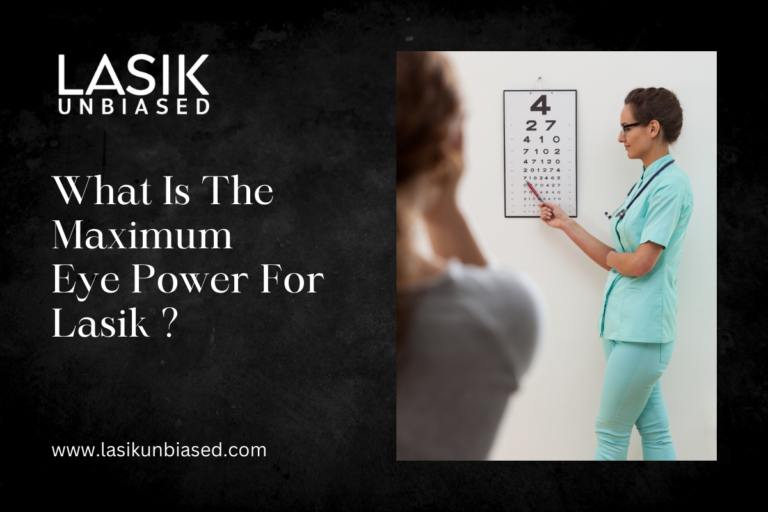Understanding LASIK and Its Limits
LASIK is a popular vision correction procedure that reshapes the cornea to correct refractive errors such as nearsightedness, farsightedness, and astigmatism. However, there are limitations to how much eye power LASIK can correct. The maximum prescription for treatment depends on factors like corneal thickness, eye health, and the technology used during the procedure. While LASIK offers excellent results for many patients, not everyone is a suitable candidate for the surgery.
Maximum Eye Power for Nearsightedness (Myopia)
For nearsightedness, LASIK can typically correct up to -8.00 to -10.00 diopters. Some advanced laser systems may allow treatment beyond this range, but the results’ success rate and long-term stability decrease with higher prescriptions. If the eye power exceeds -10.00 diopters, alternative therapies like implantable collamer lenses (ICLs) or refractive lens exchange (RLE) may be better. Patients with highly high myopia often have thinner corneas, which can make LASIK riskier. An eye surgeon may recommend alternative procedures that provide safer and more compelling vision correction in such cases.
Maximum Eye Power for Farsightedness (Hyperopia)
LASIK can correct up to +4.00 to +6.00 diopters for farsightedness in most cases. However, the higher the prescription, the less predictable the results may be. Hyperopia correction is more complex than myopia correction because the laser needs to steepen the cornea rather than flatten it. Patients with high hyperopia may also experience a more extended recovery period, and the risk of regression is higher. In cases where LASIK is not suitable, procedures like refractive lens exchange (RLE) may be recommended instead.
Maximum Eye Power for Astigmatism
Astigmatism occurs when the cornea is irregular, causing blurred vision at all distances. LASIK can usually correct astigmatism up to 5.00 diopters, but the exact limit depends on individual factors such as corneal thickness and stability. Advances in LASIK technology have made astigmatism correction more precise, but higher levels of astigmatism may require customized treatments or alternative surgical options. Patients with extreme astigmatism should consult an experienced ophthalmologist to determine the most effective solution for their vision needs.
Factors That Affect LASIK Eligibility
Even if a person’s prescription falls within the treatable range, other factors can influence whether they qualify for LASIK. Corneal thickness is one of the most critical factors, as LASIK requires removing a small amount of corneal tissue to reshape the eye. If the cornea is too thin, performing LASIK may weaken its structure, leading to complications such as ectasia. Additionally, overall eye health plays a crucial role. Patients with conditions like keratoconus, severe dry eyes, or uncontrolled diabetes may not be good candidates for LASIK. A thorough pre-surgery evaluation, including corneal mapping and pupil size measurement, helps determine whether LASIK is a safe and effective choice.
Can LASIK Be Performed Beyond These Limits?
While the standard limits for LASIK are well-established, some advanced laser technologies claim to treat higher prescriptions. However, the risks increase as the prescription gets higher. Patients with extreme prescriptions may experience visual distortions, reduced night vision, or a higher chance of regression over time. In such cases, eye surgeons may recommend alternative procedures that provide better long-term results. Some patients with high prescriptions may qualify for custom LASIK or wavefront-guided LASIK, which can improve visual outcomes by addressing subtle irregularities in the cornea. However, even with these advanced techniques, there are still limits to how much correction can be safely achieved.
Alternative Vision Correction Options for High Prescriptions
If LASIK is unsuitable due to high eye power, alternative procedures can effectively correct vision. One such option is implantable collamer lenses (ICLs), which function like permanent contact lenses implanted inside the eye. ICLs are ideal for patients with extreme myopia or thin corneas and provide excellent visual clarity without altering the corneal structure. Another alternative is refractive lens exchange (RLE), where the eye’s natural lens is replaced with an artificial intraocular lens (IOL), similar to cataract surgery. RLE is often recommended for patients with high hyperopia or early signs of presbyopia.
Long-Term Stability of LASIK for High Prescriptions
For patients with prescriptions close to the upper limit, the long-term stability of LASIK results is a crucial consideration. While many patients enjoy years of clear vision after LASIK, those with higher prescriptions may experience some regression, where the eyes gradually return to their original prescription over time. This happens because corneal tissue may shift slightly, especially in individuals with stronger prescriptions. In such cases, a LASIK enhancement procedure may be needed to fine-tune vision. Patients should discuss the possibility of regression with their eye surgeon and understand whether a future enhancement might be necessary.
Importance of a Professional Eye Evaluation
Anyone considering LASIK should undergo a comprehensive eye examination with an experienced ophthalmologist. This evaluation includes tests for corneal thickness, refractive stability, and eye health to determine whether LASIK is suitable. Some patients who initially seem good candidates may discover that another vision correction procedure would provide better long-term results. Consulting with a reputable LASIK surgeon ensures the procedure is performed safely and effectively.
The maximum eye power for LASIK varies based on individual factors, but the standard limits are -8.00 to -10.00 diopters for myopia, +4.00 to +6.00 diopters for hyperopia, and up to 5.00 diopters for astigmatism. While some patients with higher prescriptions may qualify for LASIK with advanced laser technology, others may be better suited for alternative vision correction procedures. A detailed eye examination with a qualified surgeon is the best way to determine eligibility. By understanding the limits of LASIK and exploring alternative treatments when necessary, patients can make informed decisions about their vision correction options.


